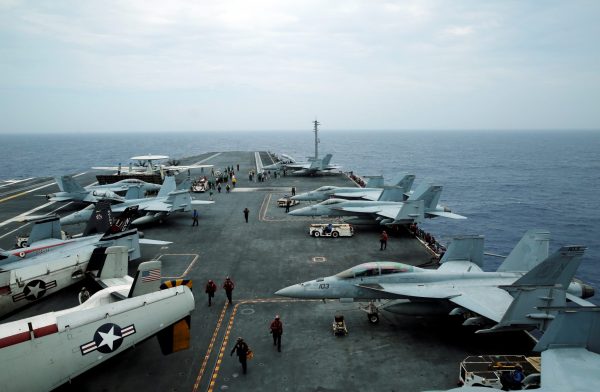Most members of the Indian strategic community suggest that this can be attributed to India’s fear of provoking the wrath of the People’s Republic of China.
Begun in 1992 as a bilateral endeavour with the United States, the Malabar exercises expanded to include other participants in the past decade, and Japan became a permanent partner in 2015. The exercises, which were initially quite modest and mostly involved promoting interoperability, have now grown in scope and become routinised as part of Delhi’s Indian Ocean strategy.
In the early 1970s India was one of the prime movers in having the Indian Ocean declared a ‘Zone of Peace’. This did not stem from an expanding Soviet naval presence in the region but rather from Indian concerns about the US navy’s role, especially regarding the base on the island of Diego Garcia in the central Indian Ocean, which the United States acquired from the British in 1968. India’s misgivings were reinforced when the United States sent the USS Enterprise, a nuclear-powered aircraft carrier, into the Bay of Bengal in a crude attempt at coercive diplomacy during the 1971 East Pakistan crisis. Of course, beyond helping pass resolutions in the United Nations General Assembly, there was little that India could actually do to keep the United States at bay.
But today, shifts in the global distribution of power — especially the rise of China — mean that far from seeking to keep the United States at an arm’s length, India is now actively, if fitfully, seeking an expanded US naval posture in the region as a hedge against a potentially revanchist China.
Apart from expanding the scope and dimensions of naval manoeuvres with the United States, in 2001 India created a tri-service command based in the Andaman and Nicobar Islands. This command is designed to protect India’s naval interests stretching to the Straits of Malacca in Southeast Asia. Indeed, in the aftermath of the 9/11 terrorist attacks in the United States in 2001, Indian and US navies carried out joint anti-terrorism patrols in the Straits of Malacca. After the 2004 Indian Ocean tsunami, Indian naval vessels were among the first to provide assistance to those affected in parts of Southeast Asia.
Despite India’s unwillingness to include Australia in the Malabar exercises, India has shown an inclination to participate in the Quadrilateral Security Dialogue, which involves the United States, Japan and Australia. All these efforts show that India seeks to forge a security architecture for the region.
What might such a design look like? Some clues can be garnered from Indian Prime Minister Narendra Modi’s speech to the annual Shangri-La Dialogue held in Singapore in early June 2018. Among other matters, Modi called for a ‘free, open and inclusive’ region and ‘a common rules-based order’. The latter phrase was without a doubt a not-so-veiled reference to China’s attempts to unilaterally extend its sway in various contested naval areas in the South China Sea.
What can be gleaned from India’s actions and Modi’s words is that India, at least for now, wants to steer a middle course in the Indian Ocean. India is acutely aware that the sea lanes of communication must remain unhindered because close to 90 per cent of India’s trade and energy resources pass through the Indian Ocean. India needs the security cooperation of a number of key countries — especially the United States — to maintain freedom of navigation.
But as the Modi government’s decision to not include Australia in the Malabar exercises shows, India remains wary of undertaking any actions that could needlessly pique China. Of course, this circumspection may have also flowed from India’s recent dust up with China near the Bhutan–India–China tri-junction in 2017. Having demonstrated considerable resolve against China at that strategic juncture, India may have decided that extending an invitation to Australia to participate in the Malabar exercises would be a needless provocation. It will certainly bear watching to see if India shifts its position on the issue in the near future.
Sumit Ganguly is Distinguished Professor of Political Science at Indiana University, Bloomington and a 2018–2019 Alexander von Humboldt Fellow at the University of Heidelberg.

